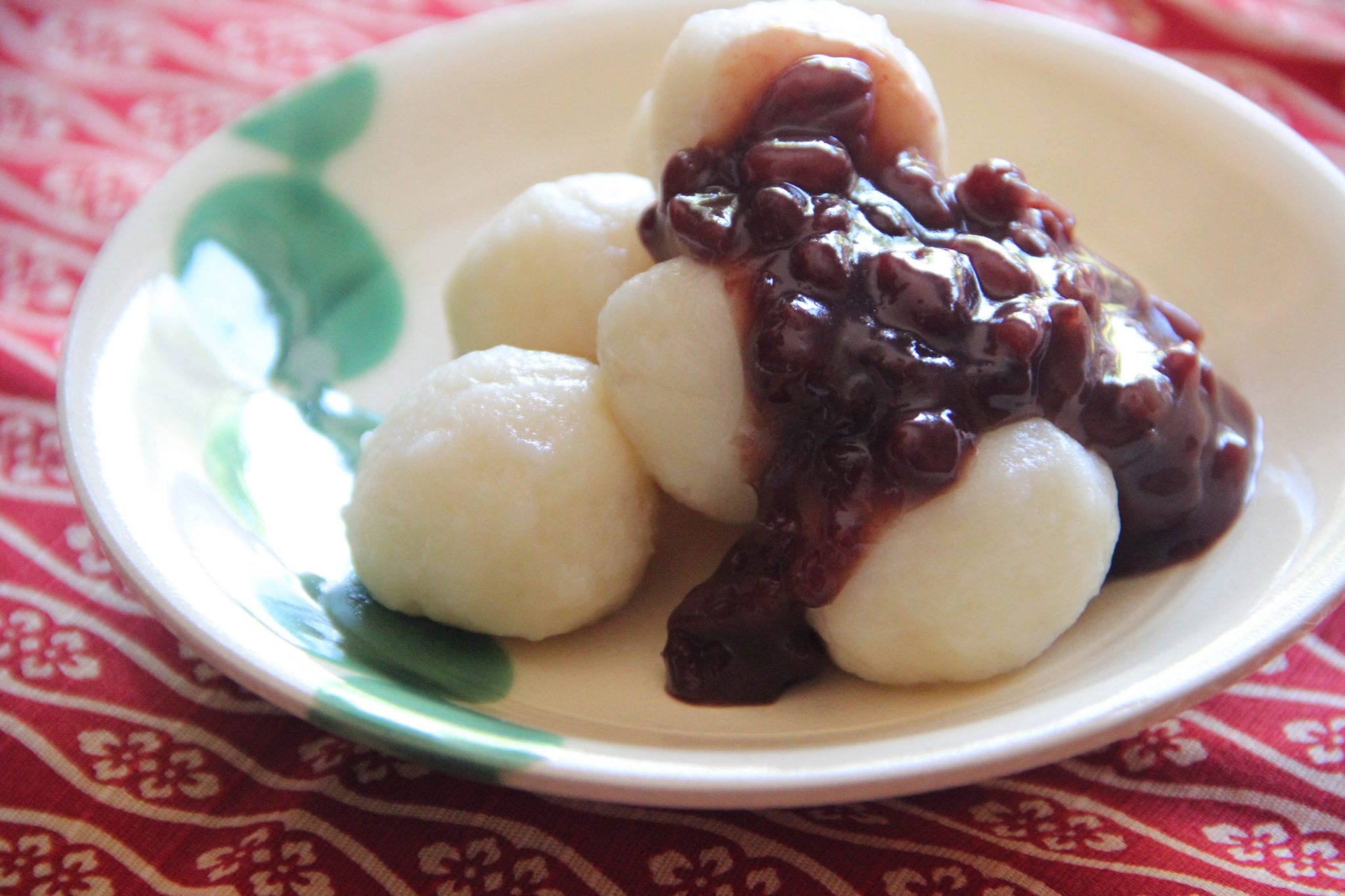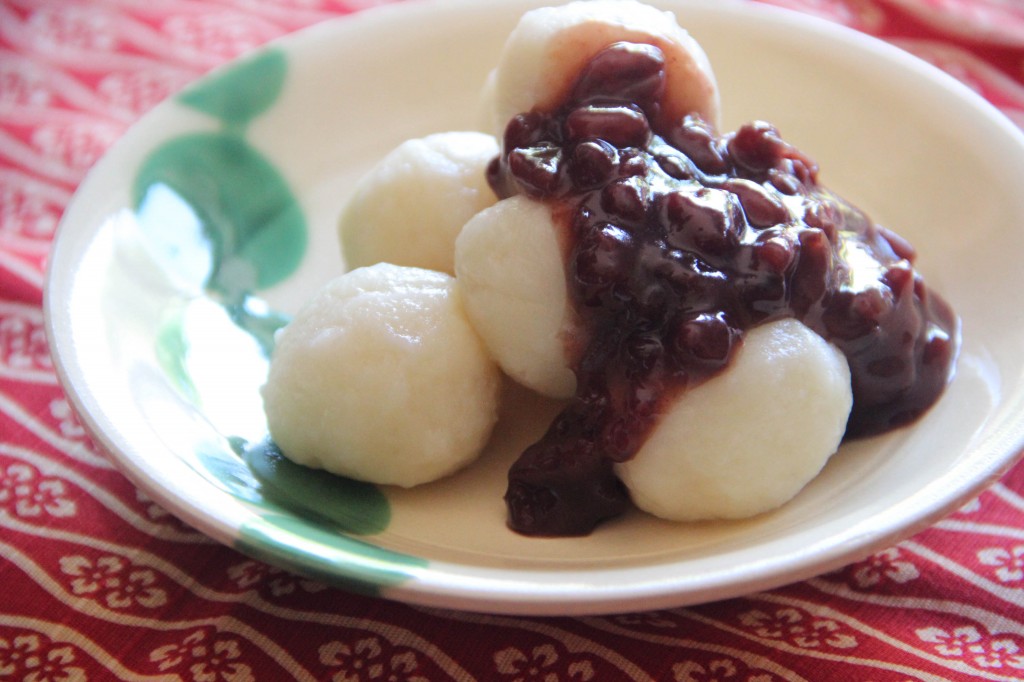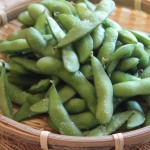Dango is a general name for small ball-shaped mochi dumplings. Usually the mochi itself is not sweetened, but toppings and sauces are. Dango are often skewered on bamboo sticks so they are easier (and more fun!) to eat. Dango are a more casual and everyday kind of traditional Japanese sweet (how elegant could it be being on skewers?) than some other formal desserts used in tea ceremony and such.
Dango can be made from different types of flour like Mochiko or Shiratamako which are made from sweet rice, and Joshinko from Japanese sticky rice. Because it is easier to find Mochiko (Koda farm brand) in a lot of grocery stores in the US, we used Mochiko in this recipe. Shiratamako, which can be found at Japanese grocery stores, works just fine too. We would not recommend to use random rice flour (other than Joshinko) because we don’t know what type of rice is used to make the flour and it may not come out glutenous enough.
There are a lot of ways to eat these chewy little morsels. Our basic Dango do not have much flavor alone, so there should be something to eat with them. Here we used Anko sweet red beans over Dango, the simplest way to eat them. Or, you could dip them in Kinako (soybean flour) with sugar or Kuromitsu (dark brown sugar syrup). You could grill them and pour on Mitarashi (sweet soy) sauce. When it’s hot out, you could put Dango balls on shaved ice. In winter, you can eat Dango with warm sweet red bean soup. The sky’s the limit!
The ingredients could not be simpler: Mochiko and tofu. It’s better to use silken (soft) tofu to have a smooth texture. Tofu makes Dango moist and soft longer than just using water. You may need to adjust the amount of Tofu depending on what you are using because the water content is often different by brand. The Dango won’t taste like tofu unless you know what’s in it (so you might taste soy bean flavor a little since you know it). If you get to know how to make this versatile Dango, you’ll be able to enjoy making a lot of different kinds of Japanese sweets later.

Dango Recipe
Instructions
- In a bowl, mix Tofu and Mochiko well with hand. The dough should be not too loose nor too firm (about the firmness of an earlobe).
- Scoop out heaping teaspoons and roll into balls.
- Boil water in a large pot, and cook the dough balls until they float. Once they float in the boiling water, cook 2-3 minutes longer, then remove from the water using a mesh strainer (or ladle) and place onto a plate lined with a paper towel.
- Serve Dango with Anko if you like.



19 Comments
Are they served hot or cold? And are they safe to freeze?
Thank you for the recipes! I love your blog!
Louis,
any way you want! Never freezed before, can’t say for sure.
I absolutely love your site! Thank you so much for taking the time to do this
Is there anyway to reheat the dango after putting it in the fridge? Also, how long is the dango good for (in the fridge)?
Thank you again!!!
Vanessa,
you could microwave a bit if it gets too hard, but it’s better to eat fresh.
You are right! This is also something I have to try making!! Thanks a lot! What other topping would go good with this besides anko? Again thanks for the recipes!! ^_^
Jah,
you can use Kinako (soybean powder) with sugar which is the simplest. Also Mitarashi sauce, sweet soy sauce sauce is very good. We will do variations of Dango soon.
Hey could you do the wagshi I want 2 know how 2 make it for my friend
Stephanie,
Dango is wagashi! We have Dorayaki recipe too. Check it out!
I really love how simple these are to make! I’m making some exactly the same as this as soon as possible.
I was just wondering how many dango are generally made from the measurements given?
Mason,
I believe about 30 pieces or so.
I don’t understand. I try and try again and again to make mochi or dango with mochiko. It seems so easy. And every time it failed. It’s never a good texture, never good at all. I don’t get it. The mochi I bought are always delicious, same for the dango, but when I tried, it doesn’t work.
How can you make a good texture, to make it “chewy”?
invi,
have you read the comments in the Sweet Mochi recipe? There are a lot of questions and answers. A lot of people have trouble with the recipe using glutinous flour. Did you use Mochiko?
Is there a specific type of Tofu I should use for this recipe? I know thre are a lot of kinds, like slik, or firm. DO you know which kind is best?
Ah, never mind. I watched the video and you already said. Sorry! XD
What exactly is the cooking time and serving size for this dish?
Kristen,
about 15 minutes and 30 pieces.
Can I use joshinko rice flour instead?
Thank you so much for the recipe- these were amazing! Perfectly soft and chewy, and delicious slathered in red bean paste. I used Blue Star Mochiko and mori-nu silken soft tofu. So delicious!
Hello! Where i live we don’t have many tofu options, silken and soft aren’t avalible. So i bought medium to firm tofu the other day (the packaging didn’t say so, i’m just guessing after comparing it to some pictures and videos). Can i use it for dango anyway? Or should i put it in a food procesor with some soy milk to get a smoother texture before mixing it with four?